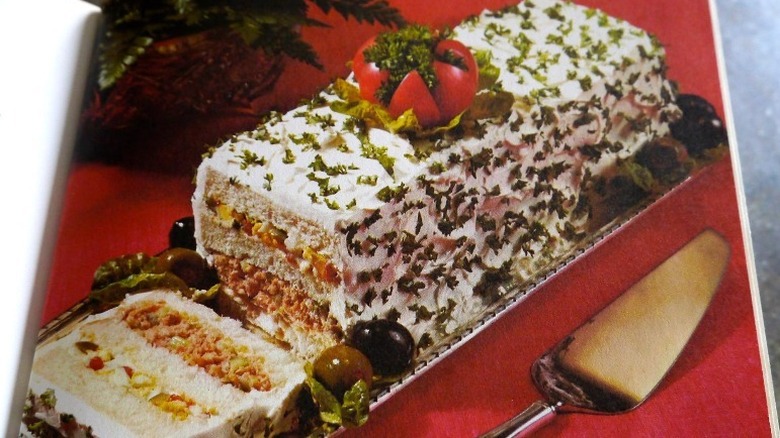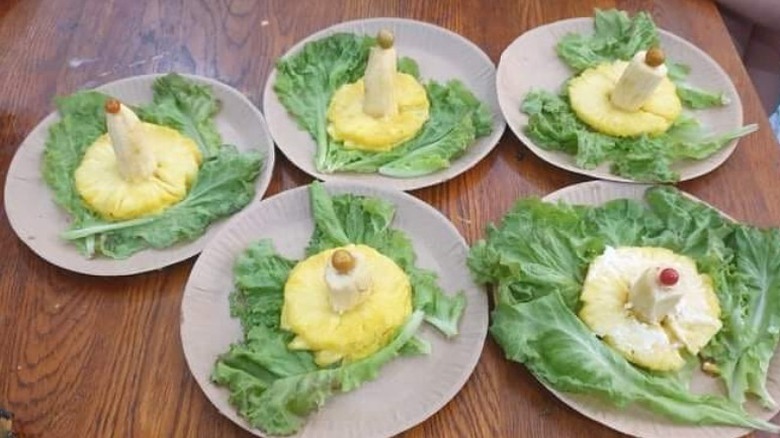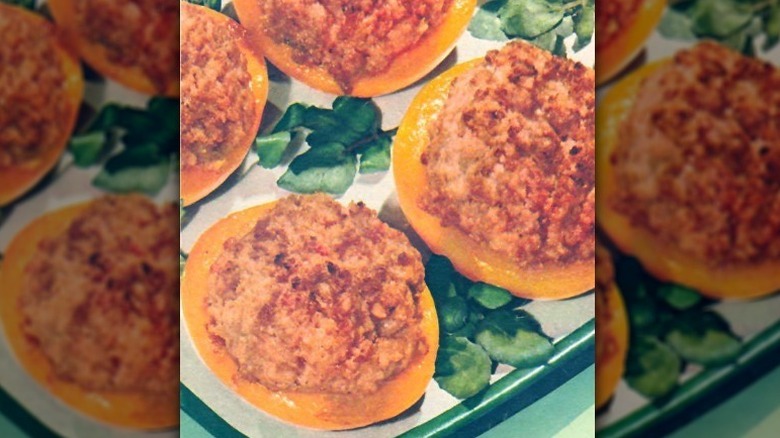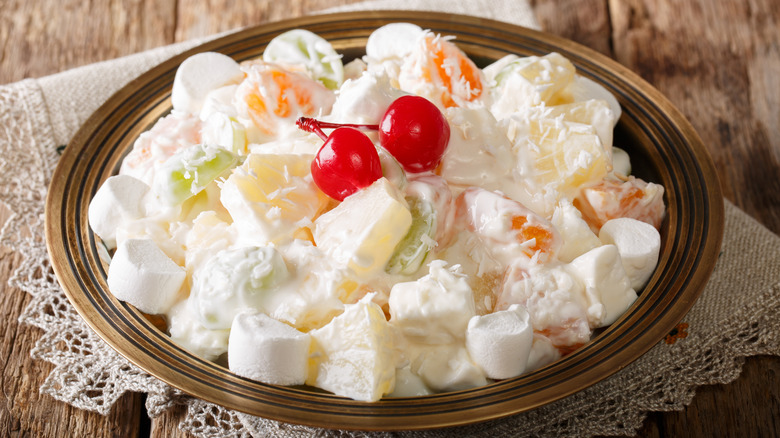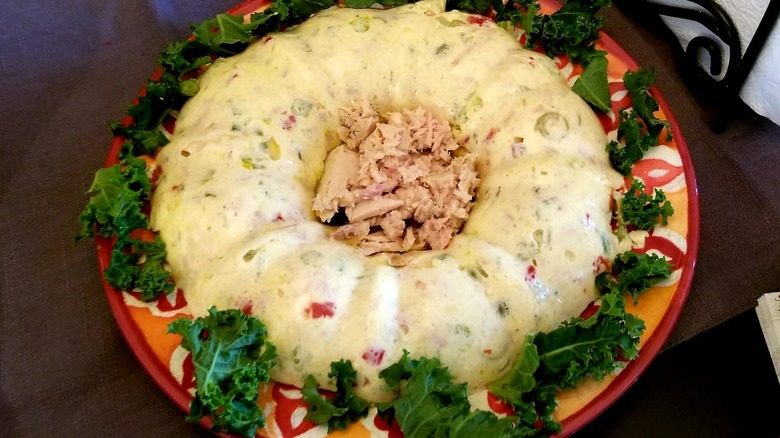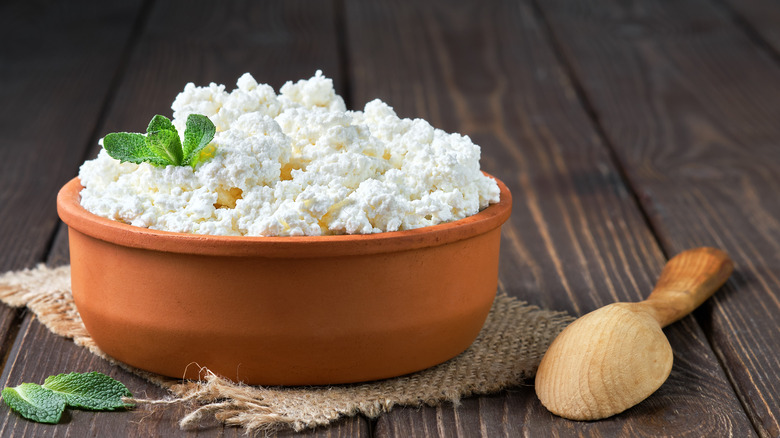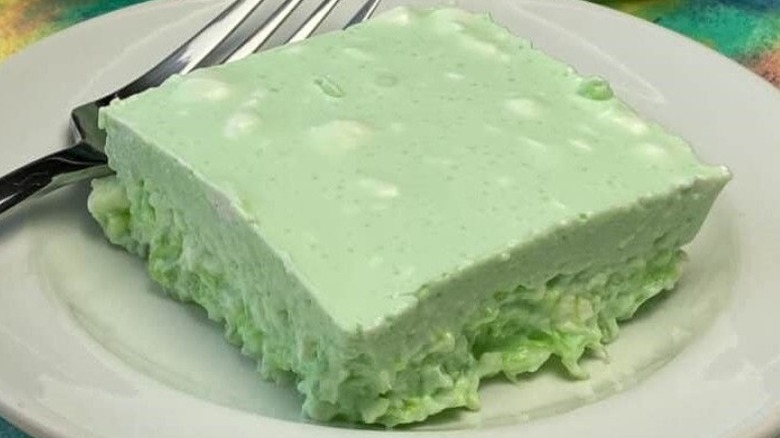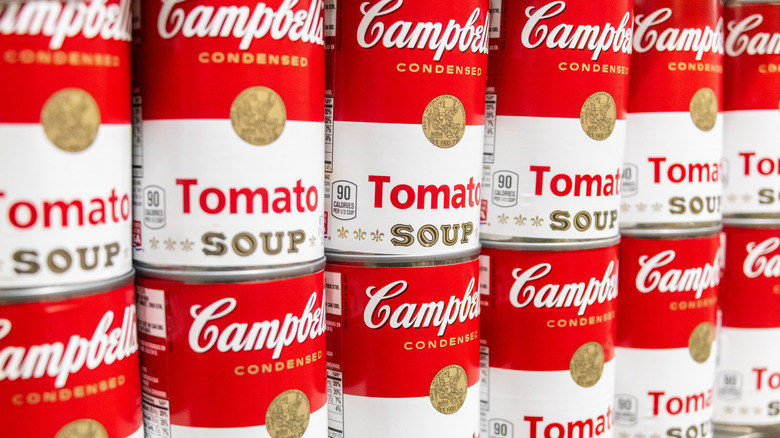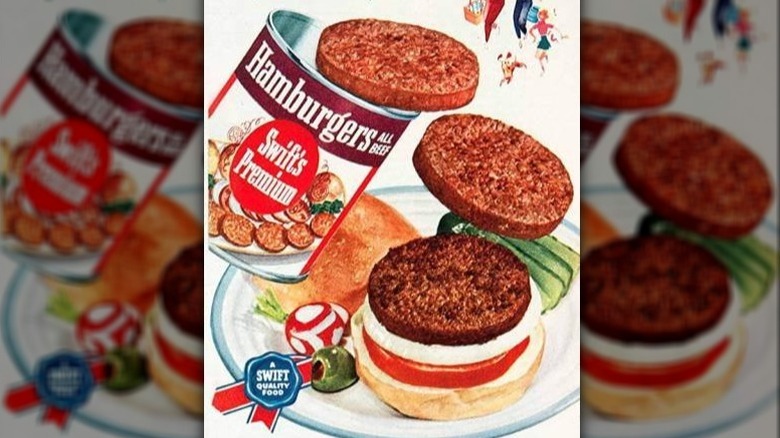Foods From The 1950s That Should Never Come Back
There's no denying that the 1950s was a strange time in world history. Much like the current era, there was a sense of foreboding on the horizon as the Cold War ramped up. At the same time, the '50s marked the rise of the homemaker in American life (via PBS). Women who had gone to work during the war now retreated to their kitchens where they were encouraged to keep their families fed with a swath of new products that were just hitting the market. From canned meats to Jell-O, it seemed like the American diet had suddenly entered a whole new realm.
Although this time period led to a lot of experimentation in the kitchen, that doesn't mean that all of it was particularly appealing. In fact, some of the recipes to have come out of the '50s were patently strange. Perhaps it came down to home cooks getting used to all the new ingredients they now had access to after the rationing during World War II. Or maybe people just had weird tastes back then.
Whatever the case may be, here are some of the foods from the 1950s we're hoping don't make a comeback anytime soon. Maybe you'll agree with us ... or maybe, you'll want to give some of these ideas a try for yourself.
Frosted ribbon loaf
It seems like in the 1950s, people didn't really know the difference between sweet and savory foods. So many of the dishes beg the question of whether the cooks forgot what course they were making along the way. That might explain the frosted ribbon loaf, which looks like a cake but actually pretty was far from it.
Click Americana features the frosted ribbon loaf recipe, describing the dish as starting out with layers of ham and eggs. This combination is then covered by a thick layer of cream cheese icing. The end result looks just like a cake, but anyone who cuts into it thinking they're about to get a sweet treat will be sorely mistaken.
Perhaps the funniest part of this recipe is the raw tomato rose placed on top for decoration. It seems pretty likely that it's there solely for presentation. The last thing we want when biting into a strangely savory cake is to get a mouthful of raw, unseasoned tomato designed to look like a flower — although it does seem to match with the strange flavor profile that's going on here. We'll have to pass.
Grapefruit Alaska
There are certainly worse dishes that came out of the 1950s, but that doesn't mean we're going to be putting grapefruit Alaska on our tables anytime soon. Basically, this dish looks like the person serving it wanted to be healthy when they started out, but then decided to scrap that idea halfway through (we've all been there, right?). According to Taste of Home, the recipe begins with a grapefruit cut in half; rum extract, whipped cream, and meringue complete the vision.
When it all comes together, suffice to say it looks pretty random. While there's nothing wrong with a light fruit salad with a creamy element, it just doesn't sound appealing to us. At least remove the grapefruit peel to make it easier to eat. Plus, it just doesn't sound very indulgent, but it still packs in the dairy and calories for seemingly no good reason. This isn't a dessert we'll be making any time soon — and we hope it doesn't work it's way back into anyone's regular dessert rotation.
Banana candle salad
In the 1950s, it seems like many of the popular dishes were less about flavor and more about appearances — and that certainly checks out with the ethos of the era. So we weren't too surprised when we came across the banana candle salad (via Kitchn). Although it's a super simple recipe, it's still not one we would make.
Your choice of pineapple rings or Jell-O bites is used to make the base. The candles themselves are made using the tips of bananas. It's safe to say that this is one of the most phallic desserts we've ever seen, which is just one of the reasons you won't find it on our tables any time soon.
But we haven't gotten to the worst part yet. While this dessert looks questionable, the combo of banana and Jell-O doesn't sound too bad, right? Well, there's a good chance you'll be just as turned off as we were when we found out that some versions of this recipe use mayonnaise to mimic melted candle wax. And that's precisely where this recipe lost us. We're glad banana candle salads haven't yet made a resurgence in the modern-day.
Spam fiesta peach cups
Listen, we love a good fruit and meat combo, but that doesn't mean that every kind of fruit and meat is eligible for creating this type of mashup. And if you ask most people, they will probably tell you that Spam is the type of meat that you should treat a little more carefully. That's why we were absolutely shocked by a recipe for Spam fiesta peach cups (via Star Tribune).
The recipe calls for ground Spam, rolled oats, milk, ketchup, and mustard. Yes — the ketchup is the most cursed of additions here. Basically, you just mix all of the ingredients and stuff them into halved peaches. But do you use fresh peaches? Of course not, it's the '50s. Instead, the recipe calls for canned peaches.
Finally, you broil the concoction for 10 to 12 minutes, letting the ostensibly rancid smell fill your home until your guests feel forced to leave. Or at least that's how we imagine it going, anyway. We might have to live our lives without ever tasting Spam fiesta peach cups. Oh well!
Ambrosia salad
Ambrosia salad is sometimes still made in home kitchens today, but we're here to pass along an important message: It's not good. Do you want a fruit salad or a proper dessert? Make up your mind! But this recipe can't. Taste of Home's version calls for mandarin oranges and pineapple tidbits. If you really want to feel like you're in a '50s-era kitchen, we suggest buying them canned instead of fresh. You want to stay true to the spirit of the recipe, right? This combination isn't too bad on its own, nor does the addition of shredded coconut turn us off.
The real problem comes with the next two ingredients which are so bad it's almost too painful for us to type them out. Ready? Marshmallows and sour cream. Yes, you read that right. You add both marshmallows and sour cream to this dish, and then basically just mix everything together and serve it to your guests.
There's a good chance that most people would just avoid it if you were to serve ambrosia salad at a party, but there may be some folks out there who still like it. We respect their taste, but we hope they know that they're wrong for liking such an abomination of a dessert. We had better not start seeing this one on restaurant menus anytime soon.
Monterey souffle salad
When you think of vintage recipes, what comes to mind first? If you were to say unhinged Jell-O recipes (often molded into strange shapes), we would completely agree with you. Perhaps one of the oddest is the Monterey souffle salad, described as perfect "to tempt lazy summertime appetites." But leave it out on the counter for more than five minutes, and your guests may gag when you try to feed it to them.
Lemon-flavored Jell-O is the star of the show, but it gets a helping hand from the unlikely additions of mayonnaise and tuna. Don't forget to add some olives and grated onion to the mix! Granted, the lemon and fish combo does have it's shining moments... but this isn't it. If this was the '50s idea of a salad, then we're just going to skip this course entirely. This recipe was created by Starkist, a tuna company that's still going strong to this day. We're glad that they've given up on these marketing campaigns and let us eat our canned fish in peace now.
Orange Delight
We love a cheese-based dessert. It's hard to deny the pure joy of a sweet dairy-filled concoction. But when it comes to cottage cheese, we have to draw a boundary — especially if you're looking at recipes from the 1950s. One particularly disturbing dish we came across is called orange delight. If you're curious to make it, then Plowing Through Life walks you through the steps.
This dessert salad is mostly comprised of cottage cheese and orange Jell-O. Yes, you read that right — people in the '50s actually combined chunky dairy products and Jell-O. Fruit was sometimes added to the mix, which you would think might make it taste better, but it would probably just end up being even chunkier. We don't know what they were going for here with the flavor profile. Creamy? Fruity? Sweet? All of the above? Although most of us probably wouldn't consider this dish a salad these days, the liberal use of the term in the 1950s resulted in some pretty strange concoctions.
Lime cheese salad
What would a list of questionable foods from the 1950s be without several Jell-O recipes? A lime cheese salad could entail a lot of things, but the recipe displayed in a Good Housekeeping spread from 1952 sets us straight. The salad is made up of lime Jell-O, cottage cheese, and — of course — mayo. On top of that, it calls for grated onion and vinegar.
The recipe sounds easy enough, so if you feel like you ever want to give it a try, you should go for it. But you couldn't tempt us to eat lime Jell-O-tinted cottage cheese if our lives depended on it. It's such a strange combination that it really makes us question what recipe developers were thinking at the time. And the strange bar-shaped nature of the dish makes us question why ever thought it qualified as a salad. Considering the ubiquity of these kinds of recipes, maybe it wasn't as bad as it sounds. But honestly, we're probably not brave enough to give it a try.
Ham banana rolls
If there's one takeaway we've gotten from the food served in the 1950s, it's the fact that branded recipes were super common. It seems like food companies wanted to give people an excuse to buy their products, so they came up with trendy recipes that would require their purchase. One of the strangest concoctions has to be Chiquita's ham banana rolls.
While this seems like an odd recipe — and probably not one that we would ever make — we get the idea behind it. A combination of sweet and savory foods is usually a good idea, and it's not like pineapple and ham haven't been put together in a dish before. But ham and banana? And that's not the worst part.
Basically, whole bananas are wrapped in boiled ham and covered in mustard, margarine or butter, and a cheese sauce. We've got to hand it to Chiquita for coming up with something so simple. Nonetheless, it doesn't exactly stimulate our appetites to look at pictures of the finished product.
Campbell's soup sandwiches
So, you have a can of soup in your pantry. What should you do with it? Make a sandwich, right? Although that may not be our first line of thought these days, it's apparently what Campbell's wanted people to do with their products back in the 1950s.
A 1950s Campbell's print ad shows readers exactly how to make this strange combo: Essentially, just make a normal sandwich and then pour the soup on top. The pictures make the soup look like gravy, but if it's anything like the Campbell's soups we have these days, it's probably just going to soak your bread in an instant and leave you with a big mess to clean up.
We don't know when Campbell's caught on to the fact that you could simply dip a corner of your sandwich into a soup and get the same result without the mess. Considering we haven't seen this kind of recipe in our lifetimes, we're going to assume that they got the memo.
Canned hamburgers
Look, we're all for convenience. Sometimes, you don't have time to make a good meal from scratch, and you're probably better off having some convenience foods in the house so you don't just turn to ice cream and popcorn for dinner. But convenience foods can go too far, which is exactly how we feel about canned hamburgers.
Canned meat was especially popular during the 1950s, with the rise of Spam and other shelf-stable, nuclear-friendly foods. Some of the canned meats that are still around today aren't half bad. But we're very glad we've never attended a backyard barbecue where canned burgers were being served. (And we hope we never do.)
We have to wonder: Were they sweaty and moist? Did people just eat them cold? Were they invented so you could have a burger at your desk during lunch? It's a strange concept. If we were forced to eat canned meat, we'd probably just stick with Spam instead.

